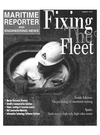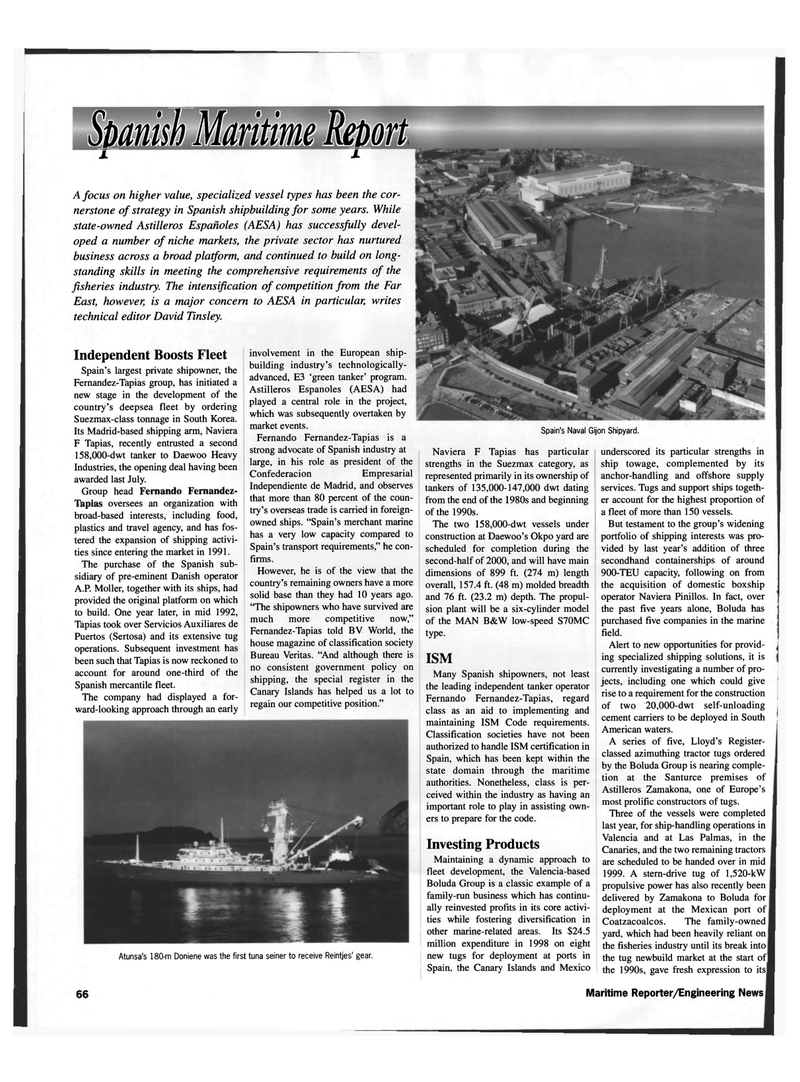
Page 66: of Maritime Reporter Magazine (March 1999)
Read this page in Pdf, Flash or Html5 edition of March 1999 Maritime Reporter Magazine
Spanish Maritime Report
A focus on higher value, specialized vessel types has been the cor- nerstone of strategy in Spanish shipbuilding for some years. While state-owned Astilleros Espaholes (AESA) has successfully devel- oped a number of niche markets, the private sector has nurtured business across a broad platform, and continued to build on long- standing skills in meeting the comprehensive requirements of the fisheries industry. The intensification of competition from the Far
East, however, is a major concern to AESA in particular, writes technical editor David Tinsley.
Independent Boosts Fleet
Spain's largest private shipowner, the
Fernandez-Tapias group, has initiated a new stage in the development of the country's deepsea fleet by ordering
Suezmax-class tonnage in South Korea.
Its Madrid-based shipping arm, Naviera
F Tapias, recently entrusted a second 158,000-dwt tanker to Daewoo Heavy
Industries, the opening deal having been awarded last July.
Group head Fernando Fernandez-
Tapias oversees an organization with broad-based interests, including food, plastics and travel agency, and has fos- tered the expansion of shipping activi- ties since entering the market in 1991.
The purchase of the Spanish sub- sidiary of pre-eminent Danish operator
A.P. Moller, together with its ships, had provided the original platform on which to build. One year later, in mid 1992,
Tapias took over Servicios Auxiliares de
Puertos (Sertosa) and its extensive tug operations. Subsequent investment has been such that Tapias is now reckoned to account for around one-third of the
Spanish mercantile fleet.
The company had displayed a for- ward-looking approach through an early involvement in the European ship- building industry's technologically- advanced, E3 'green tanker' program.
Astilleros Espanoles (AESA) had played a central role in the project, which was subsequently overtaken by market events.
Fernando Fernandez-Tapias is a strong advocate of Spanish industry at large, in his role as president of the
Confederacion Empresarial
Independiente de Madrid, and observes that more than 80 percent of the coun- try's overseas trade is carried in foreign- owned ships. "Spain's merchant marine has a very low capacity compared to
Spain's transport requirements," he con- firms.
However, he is of the view that the country's remaining owners have a more solid base than they had 10 years ago. "The shipowners who have survived are much more competitive now,"
Fernandez-Tapias told BV World, the house magazine of classification society
Bureau Veritas. "And although there is no consistent government policy on shipping, the special register in the
Canary Islands has helped us a lot to regain our competitive position."
Spain's Naval Gijon Shipyard.
Atunsa's 180-m Doniene was the first tuna seiner to receive Reintjes' gear.
Naviera F Tapias has particular strengths in the Suezmax category, as represented primarily in its ownership of tankers of 135,000-147,000 dwt dating from the end of the 1980s and beginning of the 1990s.
The two 158,000-dwt vessels under construction at Daewoo's Okpo yard are scheduled for completion during the second-half of 2000, and will have main dimensions of 899 ft. (274 m) length overall, 157.4 ft. (48 m) molded breadth and 76 ft. (23.2 m) depth. The propul- sion plant will be a six-cylinder model of the MAN B&W low-speed S70MC type.
ISM
Many Spanish shipowners, not least the leading independent tanker operator
Fernando Fernandez-Tapias, regard class as an aid to implementing and maintaining ISM Code requirements.
Classification societies have not been authorized to handle ISM certification in
Spain, which has been kept within the state domain through the maritime authorities. Nonetheless, class is per- ceived within the industry as having an important role to play in assisting own- ers to prepare for the code.
Investing Products
Maintaining a dynamic approach to fleet development, the Valencia-based
Boluda Group is a classic example of a family-run business which has continu- ally reinvested profits in its core activi- ties while fostering diversification in other marine-related areas. Its $24.5 million expenditure in 1998 on eight new tugs for deployment at ports in
Spain, the Canary Islands and Mexico underscored its particular strengths in ship towage, complemented by its anchor-handling and offshore supply services. Tugs and support ships togeth- er account for the highest proportion of a fleet of more than 150 vessels.
But testament to the group's widening portfolio of shipping interests was pro- vided by last year's addition of three secondhand containerships of around 900-TEU capacity, following on from the acquisition of domestic boxship operator Naviera Pinillos. In fact, over the past five years alone, Boluda has purchased five companies in the marine field.
Alert to new opportunities for provid- ing specialized shipping solutions, it is currently investigating a number of pro- jects, including one which could give rise to a requirement for the construction of two 20,000-dwt self-unloading cement carriers to be deployed in South
American waters.
A series of five, Lloyd's Register- classed azimuthing tractor tugs ordered by the Boluda Group is nearing comple- tion at the Santurce premises of
Astilleros Zamakona, one of Europe's most prolific constructors of tugs.
Three of the vessels were completed last year, for ship-handling operations in
Valencia and at Las Palmas, in the
Canaries, and the two remaining tractors are scheduled to be handed over in mid 1999. A stern-drive tug of 1,520-kW propulsive power has also recently been delivered by Zamakona to Boluda for deployment at the Mexican port of
Coatzacoalcos. The family-owned yard, which had been heavily reliant on the fisheries industry until its break into the tug newbuild market at the start of the 1990s, gave fresh expression to its 66 Maritime Reporter/Engineering News

 65
65

 67
67
